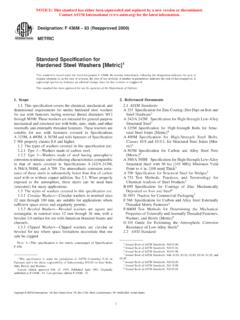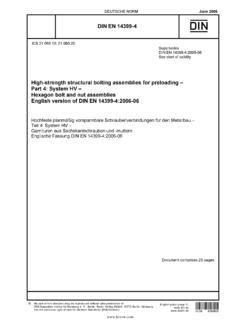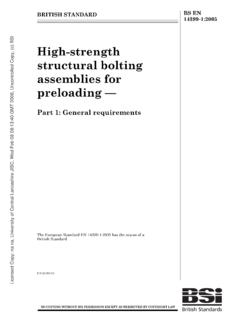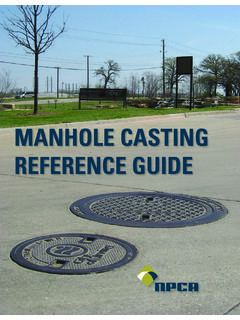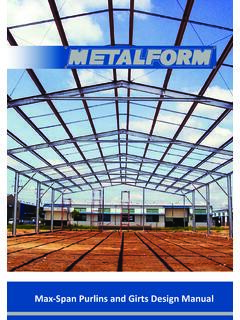Transcription of INTERNATIONAL ISO STANDARD 898-2 - itc.co.ir
1 INTERNATIONAL STANDARD ISO 898-2 Second edition 1992-11-01 -ce-p- -- -- -0------- -Pp .--0 - _____ - _^._ __--- _____ __ ----- --- Mechanical properties of fasteners - Part 2: Nuts with specified proof load values - Coarse thread Caract&-istiques rmkxniqrres des t%ments de fixatim -- Partie 2: Eo-aus avec charges d i+renve specifi6es - Filetages 2 pas CJI-OS --- --__I~._~~---I--- --~ _-_-_ _-_cp ---__-_--_- ------ _____-__-- p-__--_- __---- ___-__ ~ p___I___cw ------ ____ _ ----- -- ===-_--. - .--- .L-- -_--. --- __--- ----- .- -- _ _. ^ -- _ _ _. _ ___ :----- --= Refcrence numbcr ISO 898-2 : 19921 E) ISO 898-2 :1992(E) Fsreword ISO (the INTERNATIONAL Organization for Standardization) is a worldwide federation of national Standards bodies (ISO metnber bodies).
2 The work of preparing INTERNATIONAL Standards is normally carried out through ISO technical comtniZZees. Esch tnember body interested in a subjed: for which a technicat commitlee has been established has Zhe right 90 be represented on that cotnmittee. INTERNATIONAL organizations, govern- mental and non-govet-nmental, in liaison with ISO, also take part in the work. lS0 cotlaborates ctosely with the INTERNATIONAL Electrotechnical Commission (IEC) on alt mattet-s of etectrotechnicat standardization. Draft lntet-national Standards adapted by Iahe techllical cotm-nittees at-e circutated to the member bedies for voting. Publication as an tnter- nationat STANDARD r-equires approvat by at least 75 94 of the member bodies casting a vote.
3 INTERNATIONAL STANDARD ISO 898-2 was prepared by Technical Committee ISO/TC 2, Fasfeners, Sub-Committee SC 1, Mechanicai properfies of Tasfeners. This second edition cancels and replaces the fit-st edition (ISO 898-2 :1980), which has been technicalty revised. ISO 898 consists of ,the fotlowinq parls, under the general titte MecI~a1)- . ical proper-fies of I;r--asfeners: _I Part 1: Belts, screws arM studs -- Part 2; Nufs wifh specified proof Load values -- Coarse fhread - Part 5: Set screws and similar threaded siresses fasteriers not- under t ensile - Part 6: Abts with specilred proof Load vahes - Fine pifch thread - Part 7: Torsioriai fest ai ld minimum torques for bolts and screws with nominal dianiete/-s I mm to 10 mm Annexes A and B of Ibis pst-t of ISO 898 are for infortnation only.
4 0 ISO 1992 All rights reserved. No part of this publication may be t-cproduced or utilized in any form or by any means, electt onic or mechanical, i~~cluding photocopying and microfiltn, without permission in writing from the publisiter-. Internalional Orgat~ization for STANDARD Case Postale 56 * CH-1211 Genkve 20 ization * Switzer land Pr inteci in Switzerlatid ii INTERNATIONAL STANDARD ISO 898-2 :1992(E) MechanicaII properties of fasteners - Part 2: NUSS with specified proof load values - Coarse thread 1 Scope This INTERNATIONAL STANDARD specifies the mechanicai properties of nuts with specified proof Load values when tcsted at room temperature (sce ISO 1). Prop- erties will Var-y at higher and lower temperature.
5 It applies to nuts -- with nominai Ihrcad diameters up to and incIud- i ng 39 mm; - of trianguIar ISO thread and with diameters and pitches according to ISO 68 and ISO 262 (coarse . thread); -- with diameter/pifch combinations according to ISO 261 (coarse thread); --- with thread tolerantes 6H according to ISO 965-1 and ISO 965-2; -- with specific mechanical reguirements; I_ with widths across flats as specified in ISO 272 or equivalenl; - with nominal heights greater than or equal to O,W* ; - made of carbon steel or low alloy steel. It does not appfy to nuts requiring special properties such as -- lackirig abiliiies (sec ISO 2320); --- weldability; --- corrosion resistance (see ISO 3506); - ability to withstand temperatures a bove --t-- 300 OC or below - 50 OC.
6 NOTES 1 Nuts made from free-cutting steel should not be used above -+ 250 C. 2 For special products such as nuts for high-strength structural bolting, and overtapped nuts for use with hot- dipped galvanized boits, see the product Standards for appropriate values. 3 For assemhlies with threads having tolerantes wider than 6H/6g, there is an increased risk of stripping; see also table 1. 4 In the case of thread tolerantes other or larger than 6t-1, a decrease of the stripping strength should be con- sidered (see table 1). Table 1 - Reduction in thread strength Test load, 74 Thread Thread tolerantes greater less than or than equal to 6H 7H 6G -_ M2,5 100 -- 95,5 .-- ) 1) is the nominal diameter of the internal thread in accordance with ISO 724.
7 ISO 898-2 :1992(E) 2 Normative references ISO 6507-1: 1982, Mefallic n-,aterials ---- Hardness test - Vickers test -- Part 1: HV 5 to 1-N 100. The foIiowing Standards contain provisions which, through reference in this text, constitute provisions of this par-t af ISO 898, At the tirne of publicaiion, the editions indicated were valid. All Standards are subject to revision, and Parties to agreements based on this part of 1SO 898 are encouraged to investigate the possibility of applying the most recent editions of the Standards indicated below. Members of IEC and ISO maintain registers of currently valid Inter- national Standards. ISO 1:1975, Siandard refereuce iemperafrrre for in- dustrial length measrIrernerIts.
8 ISO 68:1973, ISO general /lur/lose screw fhreads - Basic Profile. ISO 261:1973, ISO qeneral fhreads - General i/an. ISO 262:1973, ISO general threads -- Seiected sizes for 1SO 272:1982, FasteIlers - Widths across flats. purpose metric screw purpose metric screw screws, bolts and nuts. Hexagon prodlrcts -- ISO 286-2:1988, ISO System of Limits and fits - Part 2: 7ables of STANDARD tolerante grades and limit deviations for holes and shafls. ISO 724:1978, ISO mefric screw threads - Basic di- mensions. ISO 965-1:1980, ISO general purpose metric screw threads -- Polerances --- Part 1; Frinciples and basic data. 1SO 965-2:1980, ISO yeneral purpose tnetric screw threads ---. Tolerallces - Parf 2: Limits of sizes for generai purpose holt and nuf thr,eads -- Mediwn quality.
9 ISO 4964: 1984, Steel -- Hardness conversious. ISO 6157-2:--- l) Fasteners --- Surface discontincrities , - Part 2r Nuts with threads MIS to M39. ISO 6506: 1981, Mefallic rnaterials - Hardrjess test -- Brinell test. ISO 6508:1986, Metallic rnaterials -- Hardness fest -- Rockwell fest (scales A - 8 - C - D - E - F - G - H - 0 3 Designation System Nuts with nominal heights > 0,811 (effective lengths af thread > 0,6/)) Nuts with nominal heights > 0,811 (effective lenqths of thread > 0,6D) are designated by a nur-&& to indicate the maximum appropriate pt-operty class of bolts with which they may be mated. Failure of threaded fasteners due to over-tightening tan occur by bolt shank fracture or by stt-ipping of the threads of the nut and/or bolt.
10 Shank fracture is sudden and therefore easily noticed. Stripping is gradual and therefore difficult to detect and this in- troduces the danger of partly failed fasteners being left in assemblies. lt would therefore be desirable to design thr-eaded connections so that their mode of failure would al- ways be by shank fracture but, unfortunateIy, be- Cause of the many variables which govern stripping strength (nut and bolt mate+! r,trzngths, thread clearances, across-flats dimensions, etc.), 11 uts would have to be objectionably thick to guarantee this mode in atl cases. A bolt or screw of thread M5 to M39 assembled with a nut of the appropriate propet-ty class, in accord- ancc with tabte 2, is intended to provide an as- sembly capable of beirigg tightened to the holt proof load without thread stripping occurring.
